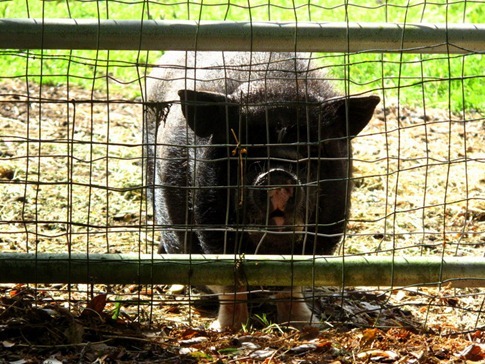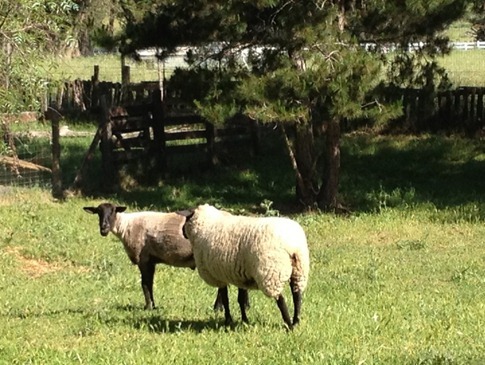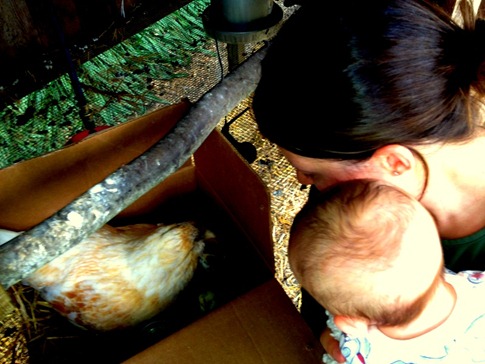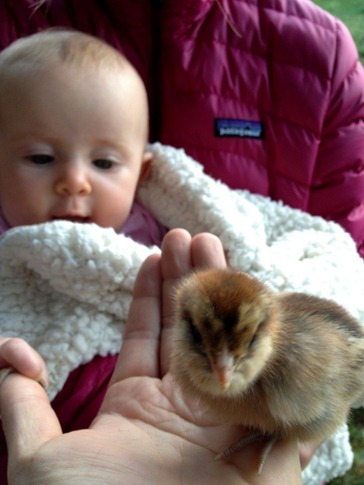“The seller has accepted your offer but with a condition.”
“What’s the condition?”
“That they can leave behind the two sheep and the potbelly pig.”
This was likely the first time our real estate agent had spoken these words to a client. And though we weren’t looking to get animals right away, seeing Petunia run to meet us at the pasture gate was quite endearing. And the sheep? Well, the sheep were just dumb; They spooked and ran every time we got within sight of them, and we figured they would just hang out and eat the grass. We agreed to take on the mini menagerie.
“Oh and by the way, the sheep probably haven’t been sheared in a couple years and need it pretty badly.”
So we got the number of a local guy and had him out to shear the sheep. As you may remember from the blog post about it, this guy stalked the skittish beasts like a wolf and ultimately pinned them into a corner before dragging their wooly masses across the pasture to his shears. When I called him again this year, he remembered me.
“Any chance you there’s a smaller area you could get them into so I don’t have to chase them around like last time? I’m just afraid they’re gonna hurt themselves bolting around like that.”
“No problem,” I assured him, “I have some electric fencing now. You may find that I’m not quite as green as I was a year ago….”
Before he arrived on Thursday morning, I laid out a small enclosure of maybe 40’ square using my Kencove electric mesh, kinda like a long volleyball net with tent poles every 10 feet. I figured I’d just herd them in there when he arrived, but as soon as they saw his car come through the gate, they were edgy. I mentioned the last time he came that I wouldn’t have been surprise if he had some canine blood in him, and they smelled him from a mile away. So like last year, he ended up stomping around the pasture after them, creating frenzied stampedes as they bolted anytime they felt the least bit closed in. When particularly panicked, they would crash themselves into the fences, trying to squeeze their 250 lb frames through holes that even chickens couldn’t fit through.
But these weren’t entirely the same skittish beasts he’d come out to shear last year. No, being conscientious new farmers, we’d done a Google search for “how can I get my sheep to like me” and based on the results, ran down to the feed store in town for some COB - a mixture of corn, oats and barley - that they loved. Nowadays, anytime we went out into the pasture, one of the dumb sheep would be nudging us with his huge black head like a puppy dog looking for a treat. So despite being a little worked up from the chase - and with the shearer/wolfman hidden behind the door of the shed - I was able to lure the big wether over to me with a bucket of the stuff. When his head was down, I made my move, grabbing two huge handfuls of that plentiful fleece on his back and holding on for a few seconds of sheep rodeo before help arrived. Together, we backed him – apparently easier than getting them to walk forwards – over to the shears. No one ever said short term memory was a strong point for sheep, and the ewe fell for the same trick a few minutes later. See, I' told you I had a new trick or two up my sleeve since last year…
Now switching topics briefly to chickens. We recently spent two weeks traveling with my family in Japan and couldn’t bring ourselves to lock them in their coop for that long. On a typical day, the flock would roam the 4 acres of the property, sifting through piles of leaves gathered along the fence lines and lounging in the shady limbs of a Cypress tree before returning just before sunset to their roosts. An automatic door on a timer would shut them in for the night, safe from marauding predators. While we were gone, we decided to allow them their freedom, scheduling a neighbor and our landscaping guy, Pedro, to come by every couple days to collect eggs and throw some alfalfa to the sheep.
The second weekend we were in Japan, we noticed all our friends commenting on Facebook about the huge electrical storm in the San Francisco Bay Area. There was even a “striking” photo of lightning hitting the Golden Gate Bridge.
Worried about the electric timer on the chicken coop, I emailed the neighbor who assured me that he’d never lost power during the storm and everything looked good with “the girls.” Unfortunately, that weekend, our web cams stopped working, I assumed a glitch with the cable internet connection caused by the storm. Yes, we have a few cameras set up around the property – the front gate, the garden, the back pasture, and the chicken coop – which we can call up from our living room or the lobby of the Westin Miyako Hotel in Kyoto. I’d used some of my past-life experience as a Web techie to write a script that would rotate the camera in the coop to face the door, snap a picture and email it to me each night, and then do the same for the roost. That way, I could confirm that everyone was in their place and safe. I hadn’t received one of these emails in a few days…
I got the text from Pedro while we were on a small tourist train from Takayama connecting to the bullet train back to Tokyo.
“Hi dave I have bad news somethin eat d chickens”
The imperfect English combined with text shorthand made the information all the more hard to grasp while winding down through rocky canyons and across bridges over green blue glacial water 5000 miles from home. I sent a reply to Pedro asking for more info – Did any survive? Did the door malfunction? What was the current scene? – but it disappeared into the 15 hour time difference, and it would take a few more days of text-tag before we knew the whole story.
Neither Ann nor I are particularly dramatic people. It’s not our style to run around to everyone and tell them the news. Instead, we just sat quietly in our train seats and talked through it. Should we have locked the coop door while we were gone and not let them range? It would have been safer but they wouldn’t have been as happy. We’d arranged for them to be checked on and the door timer could have gotten messed up even if we’d been there. How did we feel about the loss? Sure, we’d had favorites like “Mongo” who would break out of the pasture every day and stroll into the house through the sliding glass door, but at the end of the day, they were chickens. People, ourselves included, eat them every day. Just because we project some element of personality on them doesn’t mean they were aware of it themselves or wanted anything more than to scratch up the dirt and eat bugs. Clearly, we’d get more chickens and surely would think they were the best bunch we’d ever had. So, sad yes. A bit shocking, yes, but I think we were both surprised by how far we’ve come in accepting the ups and downs of homestead life. Things like this were going to be a reality, especially if we wanted to continue travelling.
When we got home, we confirmed that the door timer had lost power and likely shut the chickens out before they could get into the coop for the night. But, we also found that two of our nine chickens had survived. One, “Red,” would commonly sneak through an open corner of the pasture gate to lay her eggs on top of a fluffy bale of alfalfa in the feed shed. After some suspicion, a motion detection camera trap actually caught a farm cat sneaking into the shed to steal her egg. She likely was likely in the feed shed, roosting on top of a bucket, when the others got locked out.
The other survivor, one of our Americaunas, we found sitting in one of the nesting boxes and refusing to leave. When we asked the neighbor about it, he said she’d been doing that all week. It seems that while we were gone, she’d slipped into maternal cycle that has mostly been bred out of commercial laying chickens but still persists in the more pure breeds. When a hen “goes broody,” she stops laying eggs (which is bad for business in the egg factories) and sits on the number she’d like to hatch, called a “clutch.” Well, while this behavior likely saved her life by preventing her from being locked out of the coop, the eggs she was sitting on had not been fertilized by a rooster and hence were only good for making omelets, not baby chicks.
But, it just so happened that we were in need of some new chickens right about now. On the long flight home from Japan we’d talked about how and when we’d replace the chickens we’d lost. We were planning a few more weekends away so maybe later in the summer we would get some chicks or adopt some rescue hens. But this opportunity was too good to pass up. Our team needed a win, here. The circle of life needed to be completed. I got on Craigslist the morning after we got home and found a farm 20 minutes away in Santa Rosa offering fertile eggs from an Americauna rooster and an assortment of hens. By noon, 10 eggs new eggs were nestled under a very happy broody hen who would leave them only briefly for food and water over the course of the next 21 days.
We hadn’t realized that the 21 day incubation period would end on Mother’s Day, but it seemed fitting. Actually, our Google searches indicated that chicks hatched by a hen often arrived late on the 20th day, while those in an incubator waited until the 21st. Also, it’s interesting to note that the incubation period doesn’t start until the hen actually sets on the eggs, so though they may be laid over the course of several days, they all hatch within hours of each other. We’d spent some time on the morning of the 20th day adding fresh bedding to the nests and refilling the feeder so mama hen wouldn’t have to go far for food. Actually, we’d poured some pellets she didn’t seem to like out in a corner of the coop and replaced them with a crumble she preferred. As you’ll come to find out in a few paragraphs, I don’t mention that detail without a good reason. And sure enough, as we left for a friend’s birthday party at a nearby brew pub that afternoon, we could hear “pipping” coming from the eggs and one had a little crack in it.
We returned home that evening at dusk, the extra IPA I’d had in the last 10 minutes of the party resigning me to the backseat with the baby while Ann drove us home. As she put the little one to sleep upstairs, I walked out to the chicken coop in the fading light to check on the progress. Making my way to the egg door around the side, I noticed a fluttering inside the coop. It seems that since the automatic door was working again, a random bird stealing feed had gotten trapped inside when the door closed. Remembering that I’d read about Blue Jays killing baby chicks, I opened the large coop door at the front and left it ajar for the bird to find its way out.
Around the side, I could already hear the chirping as I approached the egg door. When I opened it, I saw a solitary head poking out from beneath our mother hen’s wing and could tell there were more wriggling around beneath her. I had heard that you shouldn’t touch the chicks until they are completely dry – remember, they’ve been slimed with egg whites for 21 days – so I took a picture with my iPhone and texted it to Ann upstairs in the baby’s room. “They hatched!”
Just then, I noticed more movement in the main part of the coop. The little bird had flown out, but now the pig and one of the large Suffolk sheep had snuck in and were gorging on the chicken pellets I’d poured out in the corner. Remember those? Despite my still IPA-influenced state, I managed to calmly sneak into the coop and slip around behind them so they had a clear path to the door. I eased closer to them, applying pressure through what I’ve heard livestock handlers refer to as my “concentric circles,” the proximity to animals at which they sense your presence at various levels like the ripples in a pond. Well, a huge rock musta fallen into the pond ‘cause out of nowhere, the big sheep panicked, lunging against the mesh that made up the side of the coop as if she was trying to get away from the man/wolf who had sheared her earlier in the week. On the third thrust against the 1/2” hardware cloth, she broke through and bolted off into the dusk, the pig waddling merrily after her through the opening left in the side of the coop. I would love to tell you it was in the perfect shape of a recently sheared sheep, but in fact it was just like the coop had been peeled open like a can of tuna.
I had to just stand there in the fading light for a second thinking, “Did that just happen?” And despite my usual rule of not mixing power tools and alcohol, found that I had little choice but to walk to the barn, fire up my compressor and grab the staple gun. With a work lamp illuminating the new emergency exit in the now dark pasture, I reattached the mesh siding as best I could, pondering how my life had changed in the past year.
The next morning, we could finally see our proud mother and her chicks. I had put 10 eggs under her 21 days before. I knew we were down to 9 because while lifting her off the clutch sometime around day 7, I’d missed one tucked under her wing; It fell from about a foot and cracked. Now, all but one of the remaining eggs was waddling around in the form of a fluffy little chick. We gave the 9th another day but when there was no movement or sound, wrote it off.
We’ve got quite an assortment: two that are very light like their surrogate mother (a Blue Wheaton Ameracauna), two that are grayish with a dark line on the head, and four that are darker red or brown. It will be really interesting to see how they all develop. And while I’ve watched more than a few YouTube videos and read articles on how to determine a chick’s gender, most end by saying that unless you’re a pro, you’re accuracy is likely to be about 50/50. I’d get the same results with eeny meeny miney mo.
It’s incredible what an instinctively good mother our little hen has turned out to be. Whereas we had to keep the chicks we got from the feed store inside and under heat lamps for the first five weeks of their lives, all these need is a warm spot under their “mother’s” wing.
I extended the nest where they had hatched by adding a cardboard box filled with hay to bring it up to the same level and set out the chick feeder and water. That night, I woke up from a deep sleep with a realization. When I checked the camera I’d set up on the brooding box, my fears were confirmed; I’d put the box directly below where “Red” roosts every night, and Mama Hen was getting brutalized from above as she sheltered her chicks under her wings. I added a feed sack thrown over the roost the next night to encourage Red to find another spot.
Baby Wynne seems very interested in these little puffballs. Little chicks and a little chick.
Around Day 3, Mama Hen led her chicks out of the nest and onto the raised mesh floor of the coop. When they reached the elevated door and ramp leading to the coop floor, Mama walked down while the chicks chose to anxiously approach the edge and throw themselves off, falling to the straw below with featherless wings flapping frantically. Once everyone was down, Mama excavated huge holes with her claws and showed them how to peck and scratch for morsels. We didn’t know what to expect but Red seemed incredibly tolerant of the little ones, even looking the other way when one jumped up to peck at her red wattle.
So while we’ll keep the coop door closed for a while to prevent entry of both predator and sheep, we have the makings of a new flock. Out of tragedy, came a triumph. Out of death, came life. The circle of life on our little farmlet is complete.




















